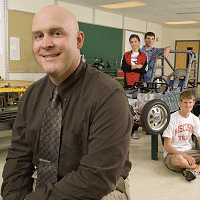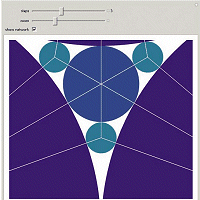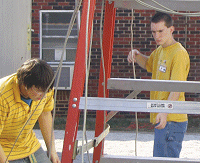Problem Solvers
##AUTHORSPLIT##<--->
US students continue to lag behind the rest of the world in the four core STEM subjects.The answer, many believe, is a practical approach to instruction: project-based
JEREMIE MEYER, AN INSTRUCTOR IN MECHANICALengineering and manufacturing, has two rooms at Preble HighSchool in Green Bay, WI. One is a typical classroom. The other,connected by a small door, is a shop, with lathes, drill presses,tubing benders, and other equipment. Meyer's students pick theirown teams and then design their own cars, using 3-D mechanicaldesign and building information modeling software fromAutodesk. They also make presentations to companies for sponsorships.One of their latest vehicles is 11.5 feet long, 47 incheswide, and 2 feet tall; it uses street-legal golf-cart tires and runs onfour 48-volt batteries. Recently, Meyer and his students showedthe car at a Wisconsin Public Service stockholders meeting, andthe company president took it for a spin—at about 35 mph.

TALKING SHOP A team of Meyer's
engineering students poses with its newest
creation: a vehicle that runs entirely on
48-volt batteries.
Meyer's preference for hands-on learning is an outgrowth of his own education. He was always encouraged by his father to fix things, to rebuild cars. He had his pilot's license in high school, even before getting his driver's license, and his first teaching position was in auto mechanics. When he got to Preble, back in 1999, Meyer pitched a Principles in Engineering class to the school board. The course, he says, makes no pretense about where its principles lie: "This is how it's done in the real world, and this is what you need to know about it."
That last utterance is likely to be met with a chorus of amens. Indeed, it could serve as the watchword for 21st-century instruction in science, technology, engineering, and math—taken together, STEM. Meyer's course puts STEM teaching to practical use, which is the way many believe the material must be taught in order for it to appeal to students, who are tuning out math and science in droves because they don't see them as having any real-world purpose. But even as the United States falls further and further behind other countries in these four critical academic areas, not everyone sees it as a crisis. Fortunately, there are those who do.
One organization out front on the issue is, fittingly, Project Lead the Way. It was in one of PLTW's pre-engineering courses that Sarah Dodge was enrolled. Begun in 1997, PLTW gives students opportunities to get hands-on STEM experience by taking STEM classes as electives. The company currently offers programs for middle schools and high schools, all standardized, with evaluations:
- Middle school. "Gateway to Technology" includes Design and Modeling, Automation and Robotics, the Magic of Electrons, the Science of Technology, and Flight and Space.
- High school. "Pathway to Engineering" consists of Introduction to Engineering Design, Principles of Engineering, Digital Electronics, Aerospace Engineering, Biotechnical Engineering, Computer-Integrated Manufacturing, Civil Engineering and Architecture, and Engineering Design and Development.
These classes can now be found in more than 1,300 schools in 45 states and the District of Columbia. PLTW helps set up partnerships between schools and businesses to supply the coursework and the teacher training.
SOFTWARE SOLUTIONS
AN ABUNDANCE OF TOOLS CAN HELP ADVANCESTUDENTS' MATH AND SCIENCE SKILLS.

- Wolfram Demonstrations Project is a collection of more than 1,300free demonstrations in math, science, and otherareas, with applications based on Mathematica6, the newest version of Wolfram Research's pioneeringmathematical software system. Assemblea rhombic triacontahedron, plot thedistribution of a bell curve, estimate the densityof a group of numbers—all on the site.
- WebLessons providesinstructions, study questions, vocabulary, quizzes, and inquiry-basedprojects, all centered around online resources such asmuseums, government institutions, educational organizations,and universities. From eLearning Systems International.
- VmathLive allows students to practicetheir math skills and compete in math activities against otherstudents from around the world. It was used for the World MathDay competition this past March, involving 250,000 students inmore than 90 countries. Vmath is a math curriculum for studentsin grades 3 through 8. Each grade level contains 10 modules;each module contains seven to 15 lessons in concept development,skill development, and problem solving.
- Straight Curve Mathematics, from Plato Learning, is K–6 supplemental classroom softwarealigned to standards set by the National Council of Teachersof Mathematics. It focuses instruction on numbersand operations, algebra, geometry, measurement, and dataanalysis and probability, and it contains mini-lessons, investigations,workshops, games, and quizzes.
- SmartHelp, from Apangea Learning, comeswith features aimed at increasing students' motivation andachievement in math, including a program that rewards progresswith points redeemable for prizes, preset learning pathways thatintegrate individual student needs, and customizable content.
- TI-Nspire is a math-learning handheld device and softwarefrom Texas Instruments that combines enhancedgraphing capabilities and standard, easy-to-use computer features.It allows you to see multiple representations of a problem on a singlescreen, use "grab and move" functions to observe relationshipsand patterns, and enter and view mathematical expressions.
"Everything we do is based on partnership," says Vice President Niel Tebbano. The organization currently has agreements with NASA, Rolls-Royce, Intel, Autodesk, the National Academy of Engineering, and more than 30 universities, engineering schools, state departments, and foundations. The partners contribute to the schools; the schools purchase the curricula and the computers (PLTW opens the hardware up for bids, so schools can purchase it from PLTW or elsewhere); and students receive training in the latest technology.
"Math and science aren't hallowed in this country," says Tebbano, a former high school principal and district superintendent. He points to the following deficits:
- American schools turn out about 60,000 engineers a year, but need 114,000.
- Math is insufficiently pushed for girls.
- Increasing emphasis is being put on performance on high stakes exams—and consequently less emphasis on learning math for its own sake.
- Traditional math and science teachers don't focus on application.
- Virtually half of the students studying engineering at the post-secondary level leave the major for other interests. They're not prepared for the rigor of the discipline, and sometimes they haven't understood exactly what engineering is.
Katherine Woodward teaches PLTW's Engineering Design and Development to 20 students at West Ashley High School in Charleston, SC, who must also be enrolled in college-prep algebra to take the course. The class is inquiry-driven and project-based. "The kids have to learn by doing," Woodward says. For her and others in Charleston, the demand for electrical engineers can't be missed: A naval base is nearby, and the local Chamber of Commerce wants to bring technologically advanced companies into the area. And what students learn in the PLTW class is invaluable. "We teach them the problem-solving skills that they don't get anywhere else," says Woodward.
In Penfield, NY, Eric Brewer teaches a high school PLTW course, but he doesn't have a background in engineering. That, he admits, has made him an even better teacher because he's had to work hard to understand the math, which helps him empathize with his students. Brewer goes to the local middle school to recruit students for his class. His pitch to the parents is the direness of the global situation; his pitch to the students is that it's cool. Students like it, he says, because "you're building stuff, you're designing things. There's definitely a coolness factor to the whole program."
 Steve Rogers has taught PLTW classes—mainly Principles of Engineering—for four years at Indianapolis' Warren Central High School. "It's unlike any other class I've had the privilege to teach," he says. The difference is the breadth of the subject matter, and the students' understanding of how it all fits together. For example, he might be explaining statics, which involves a lot of geometry, or parametrics, which involves a lot of algebra.
Steve Rogers has taught PLTW classes—mainly Principles of Engineering—for four years at Indianapolis' Warren Central High School. "It's unlike any other class I've had the privilege to teach," he says. The difference is the breadth of the subject matter, and the students' understanding of how it all fits together. For example, he might be explaining statics, which involves a lot of geometry, or parametrics, which involves a lot of algebra.
"It's the whole package," Rogers says. "You see these kids—they get it. They're in the classroom and they go, ‘Oh, that's why we learned that.' It's that application level they had never received." It's this failure of conventional school math classes to connect for students their academics and the real world that has created the crisis in STEM education, according to Rebeca Gonzalez of Chapin High School in El Paso, TX. A PLTW teacher for five years, she recalls teaching about simple machines and transformation of energy; her students could not see the relevance of what they were learning. "They had memorized the formulas, but they really didn't understand what they were doing," she says. "They already had the knowledge, but it didn't make any sense to them."
Practical Matters
Cisco Systems is another major player in STEM education. Every semester, via its numerous regional and local training centers, the Cisco Networking Academy enrolls more than 400,000 students at 10,000 sites in 164 countries. Gene Longo, the academy's senior manager for field operations, says, "As a technology company, we look to where our next engineers and developers are going to be." He points out that the United States is approaching a critical shortage of engineers and technologists, offering several reasons for that:
- There are fewer electives for students in high schools. "Are you going to risk bringing down your GPA with an elective?" he asks.
- Smaller schools can't easily offer these kinds of STEM classes because they can't draw enough students.
- "Parents aren't aware of the profession of technology. There's even a greater gap with girls."
Longo wishes people would wake up to the seriousness of the problem—or else we risk nothing less than our position globally. "We've got to look as a nation at the edge we're going to lose if we don't have students pursuing these careers," he says. "We don't seem to have the interest captured at the student level and the awareness at the parent level. The reality is, they're much more open outside the United States to these opportunities than we are. Where there's strong leadership, we make progress."
STEM-MING THE TIDE
WITH NEW JOBS FLOWING TO NON-LOCALS, ONE MEMPHIS-AREA DISTRICT CREATED ASUMMER MATH AND SCIENCE PROGRAM TO EQUIP THE CITY'S STUDENTS TO COMPETE.
AS THE CITY OF MEMPHIS, TN, began tosee more biomedical research activity inrecent years, there was a need for a localresponse—"a need for preparation," saysThomasena Stuckett, science curriculumsupervisor for the city's Shelby CountySchools. "[Local businesses] were gettingpotential employees from outside theMemphis area, and our students were notable to compete. That's where the dialoguebegan." And thus was born in thesummer of 2006 the Shelby ScholarsSummer Institute—inquiry-based activitiesin math and science for middle schoolstudents at several different locations inand around the city.
Over that summer, students learnedabout robotics, analyzing the structure andmechanics of prostheses for children.Studying alternative energy, they builtmodel solar cars and measured their efficiency—how long they'd run, how muchthey'd cost. Studying pandemics, they useda wall map to track a person with tuberculosisand calculated the probability ofinfection and the need for quarantine. Theyalso made model DNA strands of whichgenes were affected, and developed anemergency health plan for the county.Math Curriculum Supervisor Allison Clarksays, "We really push the teacher to integratetechnology into instruction."
That's teachers: Each summer institutecourse is taught by both a math teacherand a science teacher. The most recentinstitute had 190 students, and still morehad to be turned away. "Our challengeis finding enough teachers qualified toteach at this level," Stuckett says. "Wechoose these teachers because of theirflexibility, their ability to do new and innovativethings, and how well they align withour focus."
A local eighth-grade girl says she likedthe institute because she "was having funas they were mashing information into myhead." Isn't that the ultimate goal of education?
Cisco is intent on providing that leadership. The company has just come out with an evolution of its core curriculum. The curriculum now consists of two tracks—CCNA (Cisco Certified Network Associate) Discovery and CCNA Exploration; both provide an introduction to advanced technologies such as voice, video, wireless, and security.
Underpinning Cisco's success, as is true of Project Lead the Way, is its focus on hands-on learning. So says Ron Kovac, a professor/consultant at Ball State University's Center for Information and Communication Sciences. He trains regional teachers in the Cisco curricula so they can then turn around and train local instructors. Kovac says a hands-on, immersive approach is the best way to deliver both training and teaching, he says: "You can't talk about this stuff, you have to do it."
Kovac urges teachers to become more practically oriented and to demonstrate for their students the link between the curriculum and life outside. "An effective teacher is one who makes the analogies to real life," he says. "If you don't understand the world around you, how can you expect the children to understand the world they're going to be living in?"

THE CISCO KIDS After a nearby school
was burned down, Burleson High School's
Jeremy Pena (left) and Jake Melrose
helped wire a temporary building for internet
access. The two students were
enrolled in a Cisco Academy course
in network infrastructure.
What Kovac teaches in the academy gives teachers abundant exposure to practical matters. He touches on not only math and algebra, science and physics, but also electricity, electromagnetism, engineering, team problem solving and logic, and even language arts in the form of journals, presentations, and case studies at nonprofit organizations. "This program is beyond the technology stuff," he says.
Scott Stephenson, a STEM teacher at Texas' Burleson High School, where Cisco Academy courses are integrated into the general curriculum, echoes Kovac's sentiments. "You can read the material and practice doing it in a classroom, but physically going out and doing what you've learned—there's nothing better than that," he says.
After a nearby school burned down and a temporary building was occupied in its place, Stephenson and the students in his network infrastructure class wired the substitute building for internet access and then ordered the equipment. The superintendent said that their efforts saved the district at least $18,000 in labor costs. Three years ago, three of Stephenson's students as part of class discussions determined how to start an internet business—from the technical aspects to the more mundane tasks of figuring out how to make presentations. They put their learning to good use, winning a networking bid for $138,000 from an accounting firm.
The students themselves testify to the power of "actually preparing for a career and actually learning something," as Erik Bouchard puts it. Bouchard attended the academy as a high school junior and senior in Indiana. "I was pretty much learning the same things that corporate network people do," he says. Bouchard graduated in 2004 and today is senior trading support analyst for Penson GHCO, a futures company.
Synergy With Business
Corporate involvement in STEM teaching is about more than developing a future generation of scientists and engineers. There's some self-service in it too. "The more scientists and engineers in the world, the more potential customers we have," says Ray Almgren, vice president of product marketing and academic relations for National Instruments, which has been very active in promoting STEM education.
"These kids—they get it.They are in the classroomand they go, 'Oh, that's whywe learned that.' It's thatapplication level they hadnever received.
—Steve Rogers,Warren Central High School
NI established a partnership with Lego (see Product Focus) and developed Lego Mindstorms, a tool that lets children build and program robots. "We are giving back, if you will, to the initiative of exciting children with cool science and engineering technology," Almgren says. "It's true synergy."
NI contributes to STEM education in at least one other significant way: CEO James Truchard chairs the Texas STEM Industry Advisory Council. T-STEM is a $71 million initiative designed to improve instruction and academic performance in math and science at high schools across Texas. The program will create learning academies that focus on STEM subjects.
Almgren thinks schools turn off students by teaching STEM content as an abstraction. He says they simply won't recognize how pervasive technology has become in students' lives. "The education system doesn't acknowledge that the world students live in is made up of devices," he says, "and refuses to [teach] them that their world is not just a bunch of theoretical science and other objects that they don't really interact with that much." The Lego software, he says, gives some real-world context.
"I am a big fan of project-based learning. If we can get administrators to give teachers the time to develop more open learning, that might help inspire some of these kids to appreciate the technology and the math. Math is driven down kids' throats without explaining why it matters."
Kovac, the Ball State University professor, describes one of the teachers he knows, and in doing so, succinctly sums up what's needed: "You listen to her, she's not talking technology—she's talking life."
-Neal Starkman is a freelance writer based inSeattle.